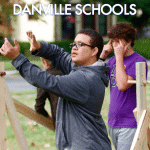District Transformation in Danville
CompetencyWorks Blog
 I’m itching to go to Danville, Kentucky after listening to Superintendent Carmen Coleman on the webinar How Competency-Based Education is Transforming Assessment and Accountability Systems in School. She walked us through the process that Danville took towards a personalized, competency-based system (fyi — Kentucky uses the term performance-based).
I’m itching to go to Danville, Kentucky after listening to Superintendent Carmen Coleman on the webinar How Competency-Based Education is Transforming Assessment and Accountability Systems in School. She walked us through the process that Danville took towards a personalized, competency-based system (fyi — Kentucky uses the term performance-based).
School Board Leadership: The school board read The Global Achievement Gap, followed by school board and educator site visits to High Tech High and NYC’s iZone. Their experience was “disturbing” as they saw that their own students weren’t being given the opportunity to do the same level of work – “even what we would have considered gap students were outperforming our AP students.” In addition to visiting schools, Danville had teacher exchanges where they brought teachers from other schools to Kentucky.
Building Shared Vision around the Danville Diploma: Any district moving towards personalization takes the time to build a shared vision. Danville redesigned their diploma to define what they want for their students and open the discussion on what type of schooling was needed. The diploma emphasizes application of content and skills. Coleman emphasized that the diploma requires Danville to be “just as intentional about skills as the academic content.”
Want to learn more about Danville? Here is a great case study of their journey.
A version of competency education is placed squarely into the Danville Diploma, with the requirement that at specific transition points (grades 5, 8, and 11), students demonstrate growth and development as a learner and productive, contributing member of the school and larger community before moving to the next level. (FYI – Competency-based districts vary in where they place the emphasis for “move on when ready,” with some focusing on units, others courses, and Danville identifying three waypoints on the K-12 learning progression.)
Projects, Performance and Design: Danville has led with a focus on project-based learning (also referred to as inquiry-based and challenge-based), performance-based assessments and design thinking. It was the only way that they could emphasize application as well as develop skills such as collaboration and perseverance. Partners were the Buck Institute and the New York Performance Standards Consortium (described as “invaluable” by Coleman).
They are now implementing a digital portfolio to give students a “bookshelf” of the evidence of their skills. “We had to move away from multiple choice assessments,” Coleman said. “They can’t provide a full picture of a student and their learning.” Students also demonstrate their learning through “defenses” and “roundtables,” where they present what they have learned and get feedback. Here is a video on Danville’s project-based approach.
Performance-based Assessment (PBA) the Key to Competency Education: Coleman took time in the webinar to describe why performance-based assessment is so important to their transformation:
- PBA provides a way to assess skills and disposition as well as content knowledge.
- To assess higher order cognitive skills, students have to be able to demonstrate the ability to transfer knowledge to new contexts or problems.
- Students learn as they engage in the process of PBA.
“And we know our students in ways we simply did not before,” Coleman added.
As Danville educators built professional skills by creating and scoring PBAs with educators from the Consortium, it became clear that they had introduced the process of calibration and tuning (a key ingredient for competency education). Danville’s journey to competency education is a natural one; once you realize there is a problem and create a shared vision that emphasizes skills, content and application, project-based learning and performance-based assessments are the natural steps. Collaborative processes for teachers to develop a shared understanding of proficiency is simply the next step.
Blended Learning: Coleman described blended learning as the “turbulence tamer.” It has been an important step in their transformation as “it allows technology to do what it can do best in providing rapid feedback to students while freeing up great teachers to do only what they can do,” Coleman said.
What’s Next? Blended math and competency-based approaches are pushing teachers to think about standards-based grading. However, don’t expect them to call it that, as they had negative experiences in the past. Coleman explained that upgrading grading policies will develop organically as educators find that they need better ways to focus on learning. Stay tuned.
Want to learn more? Here is a great case study of their journey.